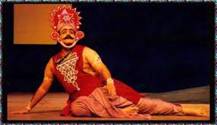| |
Translation Activity
Only literary genre that the age knew was that of drama. The only language used was Sanskrit but this was not the only one used on stage. A play was usually composed in a variety of dialects – upper caste men and ascetics spoke Sanskrit. Women spoke Prakrit and other inferior characters spoke a variety of dialects like Magadhi, Pali and Sauraseni. So while you were watching a play, you had to do simultaneous translation in some sense. But there is little written evidence of translation as an on going activity in those days. We can only infer from the works of those days. For instance, there are many similarities between Bharata’s Natyashastra and Aristotle’s Poetics. Can we see them as coincidence or could they have been influenced by each other? If there is mutual influence, there must have been a translation: how else could they understand each other?
There are other textual similarities. The medieval Italian Niccolo Machiavelli’s The Prince is very much like Arthashastra, the ancient Indian statesman Kautilya’s work on statecraft. Without a translation, Machiavelli could never have understood Kautilya. Alexander the Great’s general Megasthenes was the ambassador to Pataliputra and he even wrote a book on India called Indica. He had to be bilingual to make himself understood in Pataliputra. |